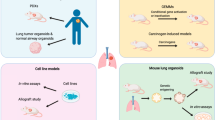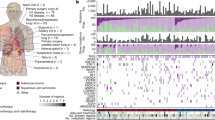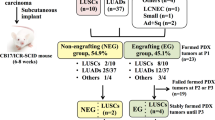Abstract
Endobronchial implantation of NCI-H460 cells into the nude rat generates a primary lung tumor with mediastinal lymph node spread, but rarely systemic metastases. We isolated tumor cells from mediastinal nodes, orthotopically reimplanted the cells into nude rats and repeated this four times to derive a cell line, designated H460SM, that spontaneously metastasizes to bone, kidney, brain, soft tissue and contralateral lung. H460SM cells demonstrated higher invasive activity in vitro than parental NCI-H460 cells. Spectral karyotyping revealed a new inversion within 17q and loss of an extra normal copy of chromosome 14 present in parental NCI-H460 cells. Expression profiling of orthotopic primary tumors revealed differential expression of 360 genes. Of these, 173 were represented in the probe set of a 19.2K OCI cDNA microarray previously used to profile the gene expression of surgically resected lung cancer specimens. We have computationally validated clinical importance of these genes by using in silico analysis of 18 cases of pulmonary adenocarcinoma, which were split into two patient groups with markedly different clinical outcome. The model identifies additional novel candidate genes for the progression of lung cancer to systemic metastases and poor prognosis.
This is a preview of subscription content, access via your institution
Access options
Subscribe to this journal
Receive 50 print issues and online access
$259.00 per year
only $5.18 per issue
Buy this article
- Purchase on Springer Link
- Instant access to full article PDF
Prices may be subject to local taxes which are calculated during checkout





Similar content being viewed by others
References
Beer DG, Kardia SL, Huang CC, Giordano TJ, Levin AM, Misek DE, Lin L, Chen G, Gharib TG, Thomas DG, Lizyness ML, Kuick R, Hayasaka S, Taylor JM, Iannettoni MD, Orringer MB and Hanash S . (2002). Nat. Med., 8, 816–824.
Bhattacharjee A, Richards WG, Staunton J, Li C, Monti S, Vasa P, Ladd C, Beheshti J, Bueno R, Gillette M, Loda M, Weber G, Mark EJ, Lander ES, Wong W, Johnson BE, Golub TR, Sugarbaker DJ and Meyerson M . (2001). Proc. Natl. Acad. Sci. USA, 98, 13790–13795.
Carney DN, Gazdar AF, Bepler G, Guccion JG, Marangos PJ, Moody TW, Zweig MH and Minna JD . (1985). Cancer Res., 45, 2913–2923.
Fontao L, Favre B, Riou S, Geerts D, Jaunin F, Saurat JH, Green KJ, Sonnenberg A and Borradori L . (2003). Mol. Cell. Biol., 14, 1978–1992.
Garber ME, Troyanskaya OG, Schluens K, Petersen S, Thaesler Z, Pacyna-Gengelbach M, van de Rijn M, Rosen GD, Perou CM, Whyte RI, Altman RB, Brown PO, Botstein D and Petersen I . (2001). Proc. Natl. Acad. Sci. USA, 98, 13784–13789.
Gayther SA, Batley SJ, Linger L, Bannister A, Thorpe K, Chin S-F, Daigo Y, Russell P, Wilson A, Sowter HM, Delhanty JDA, Ponder BAJ, Kouzarides T and Caldas C . (2000). Nat. Genet., 24, 300–303.
Gemma A, Takenaka K, Hosoya Y, Matuda K, Seike M, Kurimoto F, Ono Y, Uematsu K, Takeda Y, Hibino S, Yoshimura A, Shibuya M and Kudoh S . (2001). Eur. J. Cancer, 37, 1554–1561.
Gorogh T, Rudert H, Lippert BM, Gottschlich S, Maune S, Heidorn K, Maass J, Hoffmann M, Meyer JE, Rathcke IO, Folz BJ, Hortobagyi T and Werner JA . (1999). Int. J. Cancer, 83, 750–754.
Howard RB, Mullen JB, Pagura ME and Johnston MR . (1999). Clin. Exp. Metast., 17, 157–162.
Kang Y, Siegel PM, Shu W, Drobnjak M, Kakonen SM, Cordon-Cardo C, Guise TA and Massague J . (2003). Cancer Cell, 3, 537–549.
Kashima T, Nakamura K, Kawaguchi J, Takanashi M, Ishida T, Aburatani H, Kudo A, Fukayama M and Grigoriadis AE . (2003). Int. J. Cancer, 104, 147–154.
Kozaki K, Koshikawa K, Tatematsu Y, Miyaishi O, Saito H, Hida T, Osada H and Takahashi T . (2001). Oncogene, 20, 4228–4234.
Kozaki K, Miyaishi O, Tsukamoto T, Tatematsu Y, Hida T and Takahashi T . (2000). Cancer Res., 60, 2535–2540.
Liu J and Johnston MR . (2002). Surg. Oncol., 11, 217–228.
Liu M, Parker RM, Darby K, Eyre HJ, Copeland NG, Crawford J, Gilbert DJ, Sutherland GR, Jenkins NA and Herzog H . (1999). Genomics, 55, 296–305.
Marinissen MJ and Gutkind JS . (2001). Trends Pharmacol. Sci., 22, 368–376.
Mercer KE and Pritchard CA . (2003). Biochim. Biophys. Acta, 1653, 23–40.
Miura K, Bowman ED, Simon R, Peng AC, Robles AI, Jones RT, Katagiri T, He P, Mizukami H, Charboneau L, Kikuchi T, Liotta LA, Nakamura Y and Harris CC . (2002). Cancer Res., 62, 3244–3250.
Nakamura H, Saji H, Ogata A, Hosaka M, Hagiwara M, Saijo T, Kawasaki N and Kato H . (2003). Cancer, 97, 2798–2805.
Rhee J, Mahfooz NS, Arregui C, Lilien J, Balsamo J and VanBerkum MF . (2002). Nat. Cell Biol., 4, 798–805.
Saiga T, Ohbayashi T, Tabuchi K and Midorikawa O . (1987). In vitro Cell Dev. Biol., 23, 850–854.
Sattler M and Salgia R . (2003). Semin. Oncol., 30, 57–71.
Shaw LM, Rabinovitz I, Wang HH, Toker A and Mercurio AM . (1997). Cell, 91, 949–960.
Shindo-Okada N, Takeuchi K and Nagamachi Y . (2001). Jpn. J. Cancer Res., 92, 174–183.
Shindo-Okada N, Takeuchi K, Han BS and Nagamachi Y . (2002). Jpn. J. Cancer Res., 93, 50–60.
Sultan M, Wigle DA, Cumbaa CA, Maziarz M, Glasgow J, Tsao MS and Jurisica I . (2002). Bioinformatics, 18, S111–S119.
Tsao MS, Liu N, Chen JR, Pappas J, Ho J, To C, Viallet J, Park M and Zhu H . (1998). Lung Cancer, 20, 1–16.
Van 't Veer LJ, Dai H, van de Vijer MJ, He YD, Hart AA, Mao M, Peterse HL, van der Kooy K, Marton MJ, Witteveen AT, Schreiber GJ, Kerkhoven RM, Roberts C, Linsley PS, Bernards R and Friend SH . (2002). Nature, 415, 530–536.
Wang KK, Liu N, Radulovich N, Wigle DA, Johnston MR, Shepherd FA, Minden MD and Tsao MS . (2002). Oncogene, 21, 7598–7604.
Wigle DA, Jurisica I, Radulovich N, Pintilie M, Rossant J, Liu N, Lu C, Woodgett J, Seiden I, Johnston M, Keshavjee S, Darling G, Winton T, Breitkreutz BJ, Jorgenson P, Tyers M, Shepherd FA and Tsao MS . (2002). Cancer Res., 62, 3005–3008.
Wigle DA, Tsao M and Jurisica I . (2004). Genome Biol., 5, 309.
Acknowledgements
This work is supported by grants from the Canadian Cancer Society (NCIC Grant #012150), National Science and Engineering Research Council (RGPIN 203833-02) and the Institute for Robotics and Intelligence Systems. Dr Blackhall was supported by an unrestricted educational fellowship from Aventis Pharma Inc. (Laval, Quebec, Canada). Dr Tsao is the M Qasim Choksi Chair in Lung Cancer Translational Research. We are grateful to Dr Frances Shepherd for her continuing support in this project. We also thank Dr Squire and the Oncologic Molecular Micro-imaging Clinical Research Program at OCI/PMH for assistance in the SKY analysis on the cell lines. We thank Dr David A Adler (University of Washington) for permitting the use of karyotype ideogram for constructing Figure 3C.
Author information
Authors and Affiliations
Corresponding author
Additional information
Supplementary Information accompanies the paper on Oncogene website (http://www.nature.com/onc)
Rights and permissions
About this article
Cite this article
Liu, J., Blackhall, F., Seiden-Long, I. et al. Modeling of lung cancer by an orthotopically growing H460SM variant cell line reveals novel candidate genes for systemic metastasis. Oncogene 23, 6316–6324 (2004). https://doi.org/10.1038/sj.onc.1207795
Received:
Revised:
Accepted:
Published:
Issue Date:
DOI: https://doi.org/10.1038/sj.onc.1207795
Keywords
This article is cited by
-
Integrative detection and analysis of structural variation in cancer genomes
Nature Genetics (2018)
-
Integrin α11β1 regulates cancer stromal stiffness and promotes tumorigenicity and metastasis in non-small cell lung cancer
Oncogene (2016)
-
A Comparison of microCT and microPET for Evaluating Lymph Node Metastasis in a Rat Model
Molecular Imaging and Biology (2016)
-
Animal models and molecular imaging tools to investigate lymph node metastases
Journal of Molecular Medicine (2011)
-
Tumor–stromal interactions of the bone microenvironment: in vitro findings and potential in vivo relevance in metastatic lung cancer models
Clinical & Experimental Metastasis (2011)



